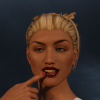Cartoonized plus Oso Toon Shaders
 CrissieB
Posts: 195
CrissieB
Posts: 195
in Art Studio
Hi all,
I'm using DAZ to illustrate my comic books and I've been experimenting with workflows for the past couple of weeks. Attached are some studies I've done with my lead character, Joan "Camo" Holder, with stylized with Cartoonized morphs.
#1 uses Oso's Toon Shaders render process, with flat colors, a lines layer, and a shading layer.
#2 is the same, with the colors posterized to give a more cell-shaded look.
#3 is a photorealistic render.
#4 is the photorealistic render, with the colors enhanced and posterized and a lines layer made with Oso's Toon Shaders.
For me, #4 'feels' the most like a hand-drawn, hand-cell-colored image. What do y'all think?


Camo Color Studies p4.jpg
2100 x 3150 - 4M


Comments
Personally, I'm not fond of posterizing; it tends to have too much of a rasterized edge.
What I prefer is to threshold the shading layer so it's essentially a two tone shadow map, blur it slightly, then use that as an Overlay or some other mode layer. Basically, 'shadow is darker and more intense'.
But that's my taste.
Nice work overall!
That looks really good! I need to play with the Oso toon shaders. Another thing to learn...
Thanks for the feedback, Oso3D and Worlds_Edge!
After a lot of back-and-forth with other comic book artists on a Discord forum, I settled on less saturation, less posterization, and a bit of blur to soften the color edges. That's the first image.
The second image is the same pose and postwork process, but shot at night with low-key lighting.
For these images I used a regular Iray render (Optimization>Path Length = 6) as the base color layer, and Oso's Toon Shaders to render a Material ID image.
In Photoshop, I stylized the base color layer with Filter>Filter Gallery>Posterize (Edge Thickness 10, Edge Intensity 0, and Posterization 4), then Filter>Blur>Gaussian Blur (1.5 pixels). For the lines, I filtered the Material ID image with Filter>Stylize>Find Edges and Desaturate, and set that layer to Multiply. Finally, I added a Levels layer to compact the colors, with settings 16-1-240 for the daytime shot and 16-1.3-240 for the nighttime shot.
I decided on a photoreal render for the base color layer for several reasons. It gives a richer skin tone, renders eyeshine and specular highlights, and easily handles glass and mirrors. (The OTS Base Color doesn't render reflections or specular highlights, and doesn't handle glass well.) That said, OTS is worth buying for its Material ID-based line process alone.
I REALLY like those, particularly the lighter one.
Another tool to consider playing with is FotoSketcher. It's free, and it has a bunch of art style filters, some procedural (like it goes through and adds brush strokes). Might be useful as a final effect. Might not, but it's free and neat.
Hi Oso3D,
FotoSketcher is wonderful! One of my characters is an artist and I use FotoSketcher to simulate her work, such as her watercolors in this scene:
Crissie
I just purchased the product OSO Toon Shader, and I can't get it to work. Is it able to operate in 4.14? I call myself following the instructions, but my renders on the first 2 procedures are just black. Can anyone tell me what I've done wrong?